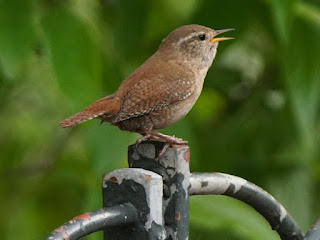A Song Thrush beside the Long Water was spurred into song by hearing another on the other side of the lake, which you can just distinguish in the first 10 seconds of this video.
A video from Spain. Nightingales sang in a street in Alcalá de Henares, famous for its ancient university, and the birthplace of Miguel de Cervantes. This was filmed at night by Emilio Pacios.
A Blackbird sang in an ash tree beside the Long Water.
Julia filmed a Great Spotted Woodpecker hard at work outside her window in Fulham.
A Wren climbed down a tree in the leaf yard in the same way as a Nuthatch, and struck just the same pose.
Another was singing on the railings at Mount Gate ...
... where the pair of Robins came out for pine nuts.
A Robin in the leaf yard brought a worm to its nest. It would have to peck it to pieces to feed the nestlings, but Robins are quite able to do that.
A Pied Wagtail perched on a buoy at the Lido.
Virginia got this remarkable backlit shot of one at sunset on the Round Pond.
Four Carrion Crows squabbled over a bit of food.
The Great Crested Grebes nesting on the Long Water have at least one chick, which you can just see on the right of this very distant shot.
A parent brought it a fish which was too large for it to eat. They are going to have a problem feeding the young because this year's fish fry haven't yet grown to a suitable size, and they don't have the Little Grebes' knack of breaking up large fish by shaking them violently.
A pair of Coots were building a nest in a silly place on the edge of the Serpentine. They'll give up in a couple of days. Even Coots eventually realise that a site is hopeless.
The Mute Swan nesting at the Lido restaurant terrace has even more large bits of branch on her nest. It seems that her mate is hauling them over to show off his strength.
The different-sized Egyptian goslings are down to five, sad but inevitable. They were alone at the Triangle and their mother, who should have been looking after them, was off with her mate fighting another Egyptian pair. These pointless territorial conflicts cost a lot of goslings.
The pair with the eldest gosling had moved to the landing stage by the Diana fountain, a good place safe from dogs. The gosling was preening its semi-adult feathers.
The five Mallard ducklings are beginning to look like adults too.






%202024%201a.jpg)






Hi Ralph, is that the SOLE cause of the Egyptian goslings rate of loss ? (Territorial disputes) Other than just merely picked off by gulls,crows etc.....as you said,sad but ineviatable...regards,Stephen...
ReplyDeleteLeaving the goslings alone exposes them to attack by gulls and crows. But these would get some even if the goslings were always attended.
DeleteI see, nothing interesting today apart from green shanks,oystercatchers, goosanders and a single kestrel.regards,Stephen..
Delete¿Qué?
DeleteI meant my sightings today from Chester...is THAT you meant by que ?.. regards,Stephen..
ReplyDeleteAh.
DeleteI used to see plenty of treecreepers in Kensington Gardens around ten years ago. Am I right in thinking that their numbers have declined snce then? Don't seem to see as many around anymore.
ReplyDeleteYes, I think they have. The most plentiful area south of the leaf yard was wrecked by the idiots feeding parakeets which turned it into a single-species desert. I've seen two Treecreepers in different parts of Kensington Gardens in the past fortnight, not managing to get pictures of either.
DeleteWhat an amazing picture of the backlit Wagtail. It does look like an angel.
ReplyDeleteTo think of Robins like little engines of hacking things to pieces makes my head reel. But there you go.
Crossing fingers and toes for the Grebe chick. Won't even voice any fear, lest it comes true.
Tinúviel